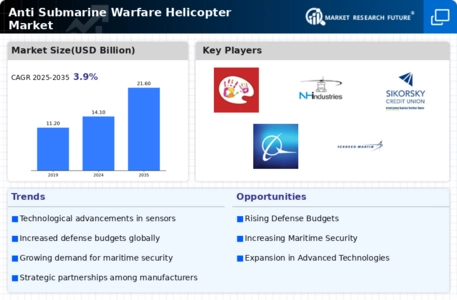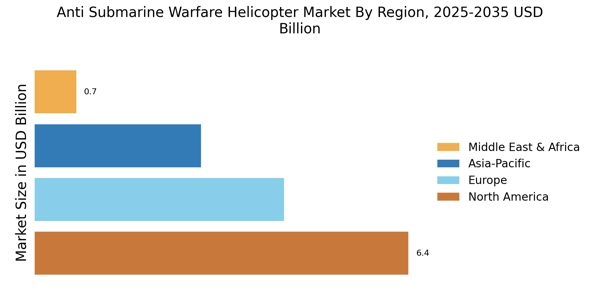Increased Geopolitical Tensions
The Anti Submarine Warfare Helicopter Market is influenced by rising geopolitical tensions among nations. As countries seek to bolster their maritime security, the demand for ASW helicopters is expected to increase. The resurgence of submarine threats, particularly in contested waters, has prompted nations to enhance their naval defense strategies. For example, the expansion of submarine fleets by various countries has led to a heightened focus on anti-submarine capabilities. This trend is reflected in defense budgets, with many nations allocating a larger portion to naval aviation and ASW technologies. The market is anticipated to grow at a compound annual growth rate (CAGR) of approximately 5% over the next five years, driven by these geopolitical dynamics.
Collaborative Defense Initiatives
The Anti Submarine Warfare Helicopter Market is benefiting from collaborative defense initiatives among allied nations. Joint exercises and shared technology development are fostering a more integrated approach to maritime security. For instance, multinational partnerships in ASW training and operations are enhancing interoperability among allied forces. This collaboration not only improves operational readiness but also drives demand for advanced ASW helicopters equipped with cutting-edge technologies. As countries recognize the importance of collective defense against submarine threats, investments in ASW capabilities are likely to increase. The market is projected to see a rise in procurement contracts as nations seek to enhance their ASW fleets through collaborative efforts.
Rising Demand for Maritime Security
The Anti Submarine Warfare Helicopter Market is experiencing heightened demand for maritime security solutions. As global trade routes expand, the need to protect these vital waterways from submarine threats has become increasingly apparent. Nations are recognizing the strategic importance of maintaining secure maritime environments, leading to increased investments in ASW capabilities. The proliferation of submarines, particularly in strategic regions, has further amplified this demand. Consequently, the market for ASW helicopters is projected to grow, with a focus on enhancing surveillance and reconnaissance capabilities. Analysts predict that the market could see a growth rate of around 6% annually, driven by the urgent need for effective maritime security measures.
Growing Naval Modernization Programs
The Anti Submarine Warfare Helicopter Market is significantly impacted by ongoing naval modernization programs across various nations. Many countries are investing in upgrading their naval fleets to counter emerging threats, particularly from advanced submarines. This modernization often includes the acquisition of new ASW helicopters equipped with state-of-the-art technologies. For example, nations such as India and Australia are actively pursuing modernization initiatives that prioritize ASW capabilities. The market is expected to witness substantial growth as these programs unfold, with estimates suggesting an increase in ASW helicopter procurement by over 30% in the next decade. This trend underscores the critical role of ASW helicopters in contemporary naval warfare.
Technological Advancements in ASW Systems
The Anti Submarine Warfare Helicopter Market is experiencing a surge in demand due to rapid technological advancements. Innovations in sonar systems, radar capabilities, and data fusion technologies are enhancing the effectiveness of ASW helicopters. For instance, the integration of advanced sensors and artificial intelligence is enabling real-time threat assessment and improved target tracking. As nations invest in modernizing their naval capabilities, the market for ASW helicopters is projected to grow significantly. According to recent estimates, the market could reach a valuation of USD 10 billion by 2027, driven by these technological enhancements. Furthermore, the development of unmanned aerial vehicles (UAVs) for ASW operations is likely to complement traditional helicopters, expanding operational capabilities and efficiency.


















Leave a Comment